In this edition:
- 42nd Annual AMSAT Space Symposium & Annual General Meeting October 24-27
- QCWA Awards AMSAT Youth and Education Programs $2,500
- VUCC Satellite Standing August 2024
- AMSAT EA’s GENESIS-A Launched
- NASA Seeks Student Missions to Send to Space in 2026, Beyond
- Changes to AMSAT TLE Distribution for August 9, 2024
- ARISS News
- Upcoming Satellite Operations
- Hamfests, Conventions, Maker Faires, and Other Events
- Satellite Shorts From All Over
The AMSAT News Service bulletins are a free, weekly news and information service of AMSAT, the Radio Amateur Satellite Corporation. ANS publishes news related to Amateur Radio in Space including reports on the activities of a worldwide group of Amateur Radio operators who share an active interest in designing, building, launching and communicating through analog and digital Amateur Radio satellites.
The news feed on http://www.amsat.org publishes news of Amateur Radio in Space as soon as our volunteers can post it.
Please send any amateur satellite news or reports to: ans-editor [at] amsat [dot] org.
You can sign up for free e-mail delivery of the AMSAT News Service Bulletins via the ANS List; to join this list see: https://mailman.amsat.org/postorius/lists/ans.amsat.org/
ANS-224 AMSAT News Service Weekly Bulletins
To: All RADIO AMATEURS
From: Radio Amateur Satellite Corporation
712 H Street NE, Suite 1653
Washington, DC 20002
DATE 2024 Aug 11
42nd Annual AMSAT Space Symposium & Annual General Meeting October 24-27
Mark your calendar now for the 42nd Annual 2024 AMSAT Space Symposium and General Meeting, October 25-27, 2024 in Tampa, Florida.
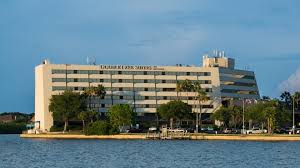
The event will be held October 25-27, 2024 at the Doubletree by Hilton Tampa Rocky Point Waterfront. Special group rate of $169 plus taxes and fees is for a standard 2-queen room. Overnight car parking is an additional $20 per night.
Note: The block of rooms for the Symposium had not been released at the time of this publication. Watch for an announcement on how to make your hotel reservations later this week.
[ANS thanks AMSAT for the above information.]
The 2024 AMSAT President’s Club coins are here now!
Help Support GOLF and Fox Plus
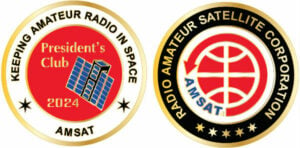
Join the AMSAT President’s Club today and help
Keep Amateur Radio in Space!
https://www.amsat.org/join-the-amsat-presidents-club/
QCWA Awards AMSAT Youth and Education Programs $2,500
Responding to a competitive Request for Proposal by the Quarter Century Wireless Association, Alan Johnston, KU2Y, AMSAT VP-Educational Relations and Frank Karnauskas, N1UW, AMSAT VP-Development submitted a request for funds to support AMSAT’s youth and educational programs. The request was fully consistent with the QCWA’s Mission Statement which reads in part “to promote interest in Amateur Radio communications and the advancement of the electronic art” especially among boys and girls essential to keep Amateur Radio and AMSAT’s ranks filled for the future growth of the hobby.
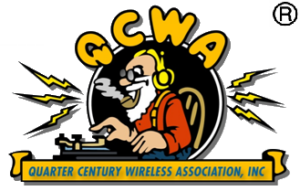
In response to its proposal, the QCWA generously awarded $2,500 to AMSAT on June 4, 2024 for its youth and educational programs.
Building on Dr. Alan Johnston, KU2Y’s ground breaking CubeSat Simulator, the QCWA contribution will help bring actual “CubeSatSims” to more classrooms, enhance instructional materials and to help build a network of online simulators to bring the benefits of this exciting resource directly to youth, their families and to educational resources of all types.
A portion of this generous gift will also be used to further the curriculum of AMSAT’s “KidzSat” program, designed to spark youth’s interest in space communications with its theme, “Satellites in Space for a Better Life Here on Earth.” For older youth the “BuzzSat” program uses Amateur Radio as the laboratory for hands-on experiences with telemetry, control and communications.
In recognition of the QCWA’s contribution to AMSAT programs, the QCWA was inducted into the AMSAT 2024 President’s Club at the Platinum level. Upon receiving news of the award, Karnauskas remarked, “Thanks to the vision of generous benefactors such as the QCWA, AMSAT is better equipped to help bring more youth into the exciting world of satellite communications and the benefits it can bring to mankind – Satellites in Space for a Better Life on Earth!”
[ANS thanks AMSAT for the above information.]
Need new satellite antennas?
Purchase M2 LEO-Packs from the AMSAT Store.

When you purchase through AMSAT, a portion of the proceeds goes towards
Keeping Amateur Radio in Space.
https://amsat.org/product-category/hardware/
VUCC Satellite Standing August 2024
VUCC Satellite Award/Endorsement Change Summary for
May 13, 2024 to August 01, 2024.
DF2ET 1402 1500
N0JE 1206 1225
WI7P 1050 1078
JK2XXK 903 1036
EA2AA 931 954
FG8OJ 888 921
KK4YEL 768 799
N8MR 706 731
JS1LQI 617 701
N3CAL 637 653
N7ZO 600 650
LA6OP 600 632
IK7FMQ 550 626
AC9DX 525 625
EA3TA 503 607
N5EKO 550 581
LY4AA 505 555
AD2DD 403 517
KF2T 399 505
AL7ID 425 502
N6PAZ 400 450
AG4W 314 423
KF0QS 301 400
W9FF 284 400
K6VHF 350 376
KB3IAI 254 358
DJ7NT 234 348
AG1A 200 301
N8HRZ 102 298
KB9DAK 255 278
N4QWF 136 255
KH6WI/W9 (EN54) New 250
KB4DSL 127 226
K0JQZ New 205
K5WO New 200
WD9EWK (DM31) 195 200
KD8RTT 101 150
BI8FFH New 132
G4BWP New 123
ER1KW New 111
XE1RCU New 108
BG6HXD New 103
KK7OVF New 103
N6NU New 103
W4BB New 100
Congratulations to the new VUCC holders.
ER1KW is first VUCC Satellite holder from Moldova and KN46
KH6WI/W9 (EN54) is first VUCC Satellite holder from EN54
BI8FFH is first VUCC Satellite holder from PM06
G4BWP is first VUCC Satellite holder from JO02
BG6HXD is first VUCC Satellite holder from OM83
W4BB is first VUCC Satellite holder from FM04
[ANS thanks Jon Goering, N7AZ, for the above information.]
AMSAT EA’s GENESIS-A Launched
AMSAT EA’s GENESIS-A module, attached to the upper stage of the Ariane-6 launcher, was put into orbit with the inaugural launch of the said rocket on July 9, 2024 from French Guiana. The module was programmed to transmit FT-8, which is, as far as the project managers know, the first time that this modulation has been used from space, as well as SSTV. Although its reception seemed impossible, a station located in Delft, the Netherlands, confirmed the reception and decoding of FT-8, as well as the reception of SSTV in orbits 3 and 4 that the stage carried out over Europe.
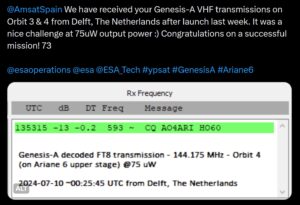
The station, belonging to the Von Storch Engineering company, has provided the IQ files of the recordings for analysis by AMSAT-EA.
Although the stage was expected to fall into the sea, this did not happen and the GENESIS-A module remains in orbit with the stage.
ESA was asked about the availability of power in the launcher stage and about the possibility of restarting the module, but the battery pack that powered YPSAT and the GENESIS-A module was completely depleted, so there is no real possibility of restarting it.
[ANS thanks Felix Paez, EA4GQS, AMSAT EA for the above information.]
NASA Seeks Student Missions to Send to Space in 2026, Beyond
NASA announced a new round of opportunities for CubeSat, developers to build spacecrafts that will fly on upcoming launches through the agency’s CSLI (CubeSat Launch Initiative). CubeSats are a class of small spacecraft called nanosatellites.
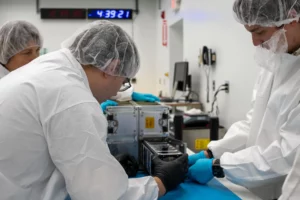
The initiative provides space access to U.S. educational institutions, certain non-profit organizations, and informal educational institutions such as museums and science centers, as well as NASA centers focused on workforce development, including the agency’s Jet Propulsion Laboratory in southern California. It also encourages participation by minority serving institutions.
“Working with CubeSats is a way to get students interested in launching a career in the space industry,” said Jeanie Hall, CSLI program executive at NASA Headquarters in Washington. “NASA reviews applications for CubeSat missions every year and selects projects with an educational component that also can benefit the agency in better understanding education, science, exploration, and technology.”
Applicants must submit proposals by 5 p.m. EST, Nov. 15. NASA expects to make selections by March 14, 2025, for flight opportunities in 2026-2029, although selection does not guarantee a launch opportunity. Applicants are responsible for funding the development of the small satellites.
Selected CubeSats get assigned a launch and deployment directly from a rocket or to low Earth orbit from the International Space Station. Once accepted, NASA mission managers act as advisors to the CubeSat team, ensuring technical, safety, and regulatory requirements are satisfied before launch. Those selected will strengthen their skills in hardware design and development and build knowledge in operating the CubeSats.
Eight CubeSat missions recently shared a ride to space on Firefly Aerospace’s Alpha rocket that launched on July 3 from Vandenberg Space Force Base in California. One mission is CatSat, built by students at the University of Arizona, which is testing a deployable antenna attached to a Mylar balloon. Another is KUbeSat-1, built by the University of Kansas, is testing a new method of measuring the cosmic rays that hit the Earth. This launch also was notable for two CSLI ‘first’ milestones. The KUbeSat-1 and another called MESAT-1 were the first CSLI missions from the states of Kansas and Maine respectively.
Four CubeSats also went to the space station as cargo in a SpaceX Dragon capsule on March 21 aboard a Falcon 9 rocket from Space Launch Complex 40 at Cape Canaveral Space Force Station in Florida as part of the agency’s SpaceX 30th commercial resupply mission. Once aboard the space station, astronauts deployed the small missions into various orbits to demonstrate and mature technologies meant to improve solar power generation, detect gamma ray bursts, determine crop water usage, and measure root-zone soil and snowpack moisture levels.
CubeSats are a class of spacecraft sized in multiples of a standardized unit called a “U.” A 1-Unit (1U) CubeSat is about 10 x 10 x 11 cm in size (3.9 x 3.9 x 4.5 inches). They are small enough to fit in the palm of your hand and can be stacked together to form a slightly larger, more capable spacecraft. A 3U CubeSat is three times the size of a 1U, a 6U is six times the size.
NASA has selected CubeSat missions from 45 states, Washington, and Puerto Rico, and launched about 160 CubeSats since inception.
The CubeSat Launch Initiative is managed by NASA’s Launch Services Program based at NASA’s Kennedy Space Center in Florida. To learn more information about CSLI, visit: https://go.nasa.gov/CubeSat_initiative
[ANS thanks JoAnne Maenpaa, K9JKM, and NASA for the above information.]
Want to fly the colors on your own grid expedition?
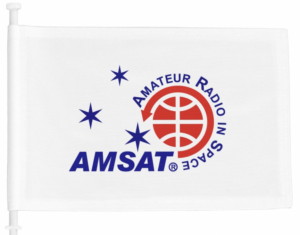
Get your AMSAT car flag and other neat stuff from our Zazzle store!
25% of the purchase price of each product goes towards
Keeping Amateur Radio in Space
https://www.zazzle.com/amsat_gear
Changes to AMSAT TLE Distribution for August 9, 2024
Two Line Elements or TLEs, often referred to as Keplerian elements or keps in the amateur community, are the inputs to the SGP4 standard mathematical model of spacecraft orbits used by most amateur tracking programs. Weekly updates are completely adequate for most amateur satellites. TLE bulletin files are updated daily in the first hour of the UTC day. New bulletin files will be posted immediately after reliable elements become available for new amateur satellites. More information may be found at https://www.amsat.org/keplerian-elements-resources/.
The following satellites have been removed from this week’s AMSAT TLE distribution:
YUSAT 1 NORAD Cat ID 47439 Decayed from orbit on or about 3 August 2024
TEVEL-1 NORAD Cat ID 51013 Decayed from orbit on or about 3 August 2024
TEVEL-3 NORAD Cat ID 50988 Decayed from orbit on or about 3 August 2024
TEVEL-8 NORAD Cat ID 50989 Decayed from orbit on or about 3 August 2024
TEVEL-7 NORAD Cat ID 51062 Decayed from orbit on or about 3 August 2024
TEVEL-4 NORAD Cat ID 51063 Decayed from orbit on or about 3 August 2024
TEVEL-2 NORAD Cat ID 51069 Decayed from orbit on or about 3 August 2024
[ANS thanks Joe Fitzgerald, KM1P, AMSAT Orbital Elements Manager, for the above information.]
ARISS NEWS
Amateurs and others around the world may listen in on contacts between amateurs operating in schools and allowing students to interact with astronauts and cosmonauts aboard the International Space Station. The downlink frequency on which to listen is 145.800 MHz worldwide.

Upcoming Contacts
A.G. Nikolaev Secondary School, Shorshel, Chuvashia, Russia direct via TBD.
The ISS callsign is presently scheduled to be RS0ISS.
The scheduled crewmember is Nikolay Chub.
The ARISS mentor is A.R.C. ENERGIA,RV3DR.
Contact is go for Sunday, August 11, 2024 at 08:20 UTC.
Blackwater State High School, Blackwater, QLD, Australia, telebridge via ON4ISS.
The ISS callsign is presently scheduled to be OR4ISS.
The scheduled crewmember is Matthew Dominick, KCØTOR.
The ARISS mentor is Shane Lynd, VK4KHZ.
Contact is go for: Thursday, August 15, 2024 at 09:43:18 UTC.
Pacific Science Center, Seattle, WA, direct via W7AW.
The ISS callsign is presently scheduled to be NA1SS.
The scheduled crewmember is Jeanette Epps, KF5QNU.
The ARISS mentor is Ryan Krenzischek, W4NTR.
Contact is go: Friday, August 16, 2024 at 18:14:35 UTC.
Tuskegee Airmen Inc. National Convention, Arlington Virginia, telebridge via K6DUE.
The ISS callsign is presently scheduled to be NA1SS.
The scheduled crewmember is Jeanette Epps, KF5QNU.
The ARISS mentor is Frank Bauer, KA3HDO.
Contact is go for: Saturday, August 17, 2024 at 17:34:57 UTC.
Completed Contacts
International Astronomical Union (IAU) General Assembly 2024, Cape Town, South Africa, telebridge via VK6MJ.
The ISS callsign was NA1SS.
The crewmember was Sunita Williams, KD5PLB.
The ARISS mentor was Frank Bauer, KA3HDO.
Contact was successful on Friday, August 9 2024.
Children’s camp “Shtormovoy” of the All-Russian Children’s Center “Orlyonok”, Orlyonok, Russia, direct via RO6C.
The ISS callsign was RS0ISS.
The crewmember was Nikolay Chub.
The ARISS mentor was A.R.C. ENERGIA, RV3DR.
Contact was successful: Saturday, August 3, 2024.
The crossband repeater continues to be active (145.990 MHz up {PL 67} & 437.800 MHz down). If any crewmember is so inclined, all they have to do is pick up the microphone, raise the volume up, and talk on the crossband repeater. So give a listen, you just never know.
The packet system is also active (145.825 MHz up & down).
As always, if there is an EVA, a docking, or an undocking; the ARISS radios are turned off as part of the safety protocol.
Note, all times are approximate. It is recommended that you do your own orbital prediction or start listening about 10 minutes before the listed time.
The latest information on the operation mode can be found at https://www.ariss.org/current-status-of-iss-stations.html
The latest list of frequencies in use can be found at https://www.ariss.org/contact-the-iss.html
[ANS thanks Charlie Sufana, AJ9N, one of the ARISS operation team mentors for the above information.]
Upcoming Satellite Operations
Philippe, EA4NF will be QRV (as KE4NF) from EL94 13-17 Aug, then EL95 25-27 Aug. Looks like this will be FM LEO only. Log as KE4NF
Jonathan @N4AKV has posted an ambitious August roving schedule on his qrz.com page. Tentative plans for a major satellite and 6m road trip through Maine, Nova Scotia, Newfoundland, and St. Pierre and Miquelon this summer. Satellite passes listed on https://hams.at for the next week include grid squares FN43, FN53, and GN16.
A growing number of satellite rovers are currently engaged in sharing their grid square activations on https://hams.at. By visiting the website, you gain easy access to comprehensive information about the operators responsible for activating specific grid squares. Additionally, you have the ability to assess the match score between yourself and a particular rover for a given pass, while also being able to identify the upcoming satellite passes that are accessible from your location.
[ANS thanks Ian Parsons, K5ZM, AMSAT Rover Page Manager, and Alex Ners, K6VHF, for the above information.]
Hamfests, Conventions, Maker Faires, and Other Events
AMSAT Ambassadors provide presentations, demonstrate communicating through amateur satellites, and host information tables at club meetings, hamfests, conventions, maker faires, and other events.
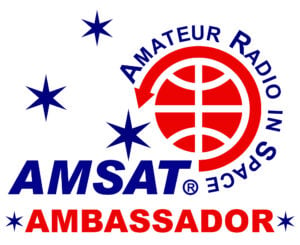
August 17-18, 2024
Huntsville Hamfest
Huntsville, AL
AMSAT Booth and Forum
N8DEU and W4FCL
August 22-25, 2024
Northeast HamXpostion
Best Western Royal Plaza Hotel & Trade Center
181 Boston Post Road W
Marlborough, MA 01752
W1EME and WD4ASW
September 7, 2024
Greater Louisville Hamfest
Shepherdsville, KY
AMSAT Forum and Information Table
W4FCL
October 5, 2024
North Star Radio Convention
Hennepin Technical College (North Campus)
Brooklyn Park, Minn.
AMSAT Forum and Information Table
KØJM and ADØHJ
October 18-20, 2024
Pacificon 2024, ARRL Pacific Division Conference
San Ramon, CA
WU0I
October 25-27, 2004
AMSAT Space Symposium and Annual General Meeting
Double Tree Rocky Point Waterfront Hotel
Tampa Bay, FL
November 2-3, 2024
Stone Mountain Hamfest, ARRL State Convention
Stone Mountain, GA
K4RGK
[ANS thanks Bo Lowrey, K4FCL, Director, AMSAT Ambassador Program for the above information.]
Satellite Shorts From All Over
Zeke Wheeler, KJ7NLL’s Desktop Satellite Tracker won First Place in Engineering and Best of Fair at the 2024 Oregon State Science Fair (Northwest Science Expo), Middle School level. Zeke presented “An Affordable Portable Orbital Desktop Satellite Tracker” at the 2024 Crowd Supply Teardown Conference. Watch Zeke’s presentation at https://www.youtube.com/watch?v=lzeoxti90Wo. [ANS thanks AMSAT for the above information.]
A Chinese Long March 6A rocket broke apart in low-Earth orbit and formed a debris field with hundreds of pieces, confirmed by U.S. Space Command. “USSPACECOM has observed no immediate threats and continues to conduct routine conjunction assessments to support the safety and sustainability of the space domain,” a U.S. Space Command spokesperson said. NASA public affairs officer Rob Margetta said there was no immediate threat to the International Space Station. Satellite monitoring company LeoLabs estimated there were at least 700 fragments created by the rocket’s break-up. While there’s no immediate danger, it’s possible that the fragments could eventually descend to where the space station and SpaceX’s Starlink satellites are located. Slingshot Aerospace said debris from the rocket poses “a significant hazard to LEO [low-Earth orbit] constellations below 800 km altitude.” More information at https://tinyurl.com/ANS-224-Debris. [ANS thanks spacedaily.com for the above information.]
AMSAT-UK is pleased to announce that the 2024 Colloquium will take place alongside the RSGB Convention at Kents Hill Park Conference Centre, Milton Keynes, MK7 6BZ on the weekend of October 13-14 2024. As in previous years, the AMSAT-UK Colloquium will run as a separate stream within the RSGB Convention and will include presentations on a variety of satellite and space related topics. The Annual General Meeting of AMSAT-UK will take place during the colloquium. More information at https://amsat-uk.org/2024/07/25/amsat-uk-space-colloquium-2024/. [ANS thanks AMSAT-UK for the above information.]
Join AMSAT today at https://launch.amsat.org/
In addition to regular membership, AMSAT offers membership to:
- Societies (a recognized group, clubs or organization).
- Primary and secondary school students are eligible for membership at one-half the standard yearly rate.
- Post-secondary school students enrolled in at least half time status shall be eligible for the student rate for a maximum of 6 post-secondary years in this status.
- Memberships are available for annual and lifetime terms.
Contact info [at] amsat [dot] org for additional membership information.
73 and remember to help Keep Amateur Radio in Space!
This week’s ANS Editor, Frank Karnauskas, N1UW
f.karnauskas [at] amsat [dot] org
